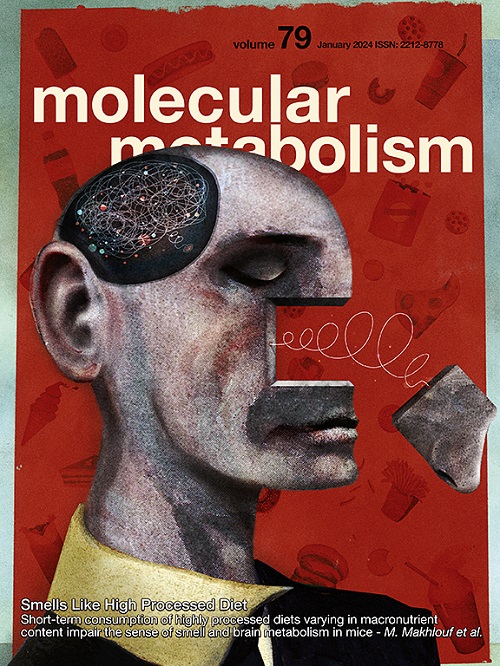Deubiquitinating enzyme USP2 regulates brown adipose tissue thermogenesis via controlling EBF2 stabilization
IF 7
2区 医学
Q1 ENDOCRINOLOGY & METABOLISM
引用次数: 0
Abstract
Objective
The activation of brown adipose tissue (BAT) promotes energy expenditure is recognized as a promising therapeutic strategy for combating obesity. The deubiquitinating enzyme family members are widely involved in the process of energy metabolism. However, the specific deubiquitinating enzyme member that affects the BAT thermogenesis remains largely unexplored.
Methods
Adeno-associated virus, lentivirus and small molecule inhibitor were applied to generate USP2 gain- or loss-of-function both in vivo and in vitro. OxyMax comprehensive laboratory animal monitoring system, seahorse and transmission electron microscopy were used to determine the energy metabolism. Quantitative proteomics, immunofluorescence staining and co-immunoprecipitation were performed to reveal the potential substrates of USP2.
Results
USP2 is upregulated upon thermogenic activation in adipose, and has a close correlation with UCP1 mRNA levels in human adipose tissue. BAT-specific Usp2 knockdown or systemic USP2 inhibition resulted in impaired thermogenic programs both in vivo and in vitro. Conversely, overexpression of Usp2 in BAT conferred protection against high-fat diet-induced obesity and associated metabolic disorders. Proteome-wide analysis identified EBF2 as the substrate of USP2 that mediates the thermogenic function of USP2 in BAT.
Conclusions
Our data demonstrated the vital role of USP2 in regulating BAT activation and systemic energy homeostasis. Activation of USP2-EBF2 interaction could be a potential therapeutic strategy against obesity.
去泛素酶USP2通过控制EBF2稳定调节棕色脂肪组织产热。
目的:激活棕色脂肪组织(BAT)促进能量消耗被认为是对抗肥胖的一种有前途的治疗策略。去泛素酶家族成员广泛参与能量代谢过程。然而,影响BAT产热的特异性去泛素化酶成员在很大程度上仍未被探索。方法:利用腺相关病毒、慢病毒和小分子抑制剂分别在体内和体外诱导USP2获得或丧失功能。采用OxyMax综合实验动物监测系统、海马和透射电镜测定能量代谢。通过定量蛋白质组学、免疫荧光染色和免疫共沉淀法揭示USP2的潜在底物。结果:在脂肪中,USP2在生热激活后表达上调,且与人脂肪组织中UCP1 mRNA水平密切相关。bat特异性Usp2敲低或系统性Usp2抑制导致体内和体外产热程序受损。相反,BAT中Usp2的过表达对高脂肪饮食引起的肥胖和相关代谢紊乱具有保护作用。蛋白质组分析发现EBF2是介导BAT中USP2产热功能的USP2底物。结论:我们的数据证明了USP2在调节BAT激活和全身能量稳态中的重要作用。激活USP2-EBF2相互作用可能是一种潜在的治疗肥胖的策略。
本文章由计算机程序翻译,如有差异,请以英文原文为准。
求助全文
约1分钟内获得全文
求助全文
来源期刊

Molecular Metabolism
ENDOCRINOLOGY & METABOLISM-
CiteScore
14.50
自引率
2.50%
发文量
219
审稿时长
43 days
期刊介绍:
Molecular Metabolism is a leading journal dedicated to sharing groundbreaking discoveries in the field of energy homeostasis and the underlying factors of metabolic disorders. These disorders include obesity, diabetes, cardiovascular disease, and cancer. Our journal focuses on publishing research driven by hypotheses and conducted to the highest standards, aiming to provide a mechanistic understanding of energy homeostasis-related behavior, physiology, and dysfunction.
We promote interdisciplinary science, covering a broad range of approaches from molecules to humans throughout the lifespan. Our goal is to contribute to transformative research in metabolism, which has the potential to revolutionize the field. By enabling progress in the prognosis, prevention, and ultimately the cure of metabolic disorders and their long-term complications, our journal seeks to better the future of health and well-being.
 求助内容:
求助内容: 应助结果提醒方式:
应助结果提醒方式:


